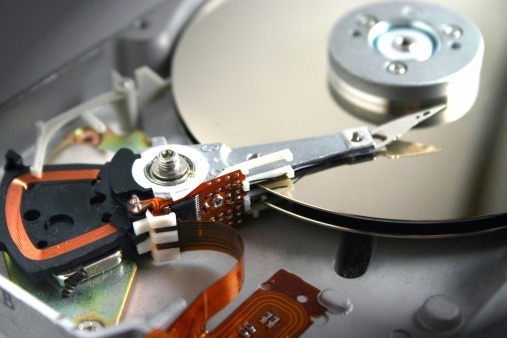Seagate Hard Drive
Seagate Hard Drive
In the event that data becomes inaccessible in the usual manner, it is necessary to call in an expert from data recovery services.
Seagate desktop and laptop hard drives have been in the hands of DSR since more than a decade, and the company has recovered data from tens of thousands of them. Seagate pioneered several cutting-edge breakthroughs in data storage technology, and while their drives are generally trustworthy, our understanding of some common issues makes the data recovery procedure more straightforward and efficient.
Recent generations of Seagate drives (particularly those introduced between the late 1990s and the mid-2000s) have seen less spindle problems than previous generations, which is an improvement over the previous generation. Spindle seizures can cause drives to stop working suddenly, and our engineers have had to execute full platter replacement procedures to retrieve data from these early generations of storage devices.

Seagate Hard Drive Failure Symptoms Include The Following:
Seagate hard drives can exhibit a wide range of failure symptoms, and some drives may exhibit a number of different symptoms at the same time, depending on the model. You will require the services of an expert data recovery evaluation in order to fully diagnose the damage.
Failures can be accompanied by the following signs and symptoms:
- Noises of Clicking
- The drive is not spinning. 7767047535
- File corruption on a large scale
- Inaccurate specifications are displayed on the hard drive (Free Space, Total Size, Etc.)
- When touched, the hard drive feels quite hot.
- The computer is unable to recognize the drive.
If you discover any indicators of media problems, turn off your computer and desist from running your hard disc until the problem is resolved. It is not recommended to use firmware utilities, data recovery software, or other apps. To speak with a Seagate hard drive data recovery expert,
dial 91-81300 64264
email us enquiry@dsrinfo.in
Seagate Hard Drive Failure Modes Explained in Basics
The following are the most common failure modes experienced by Seagate hard drives. If you are experiencing any of the following problems, we recommend that you contact a qualified Seagate data recovery services like DSR:
Defective Heads – Seagate drives with bad heads typically spin up and click multiple times before shutting down completely. Physical harm is frequently the source of this problem. The data recovery approach will comprise replacing the heads in a class 100 cleanroom environment, turning off auto reallocation and media caching, if applicable, and cloning the drive to ensure that the data is not lost during the recovery process. In order to finish this type of recovery, we will frequently need to use firmware repair equipment.
Service Track Damage – Seagate drives with service track damage will spin up and sound normal, indicating that they are in good working order. The spindle is operational and will continue to spin, however the drive may not be recognised by the operating system’s BIOS (Basic Instruction Set) (or equivalent). If it is identified, it may display an inaccurate model number, serial number, or size attribute if the device is not configured correctly. In the Seagate drives that we receive, service track difficulties are very widespread throughout the models. Depending on the drive family, the data recovery technique will be slightly different. Anyhow, we would undertake a free evaluation in order to provide an estimate before determining which data recovery technique would be most appropriate in your situation.
If Your Seagate Drive Has Electronic Or Pcb Problems – It may not spin. PCB Failure (the spindle does not engage when the drive is connected to a power source). Damaged diodes will frequently need to be removed as part of the data recovery process. It is possible that our engineers will have to change the ROM to a new printed circuit board. This procedure necessitates the use of highly specialist equipment, such as firmware repair tools, and should never be performed outside of a data recovery services laboratory setting.
Stuck Write Heads — The drive will not spin and will generate a low-pitched buzzing noise that will repeat over and over. It is anticipated that the problem will be resolved by opening the drive in a cleanroom and repositioning the heads to the landing zone/ramp area. If the heads are damaged, they will need to be replaced with a donor that is of sufficient quality.
Hard Disk Spindle Seized — The hard drive will not spin and will instead generate a low-pitched buzzing noise that will repeat repeatedly. This is an unusual occurrence on contemporary Seagate hard discs. The Seagate data recovery technique will require either a total spindle repair or a complete platter switch to a suitable donor drive to recover the lost data. It is common for this type of failure to be caused by physical abuse or dropping.
Other issues may arise, and if you observe any of the failure modes indicated above, we strongly advise that you contact a competent Seagate data recovery provider for assistance. When working with a Seagate hard drive outside of a cleanroom, use extreme caution as this could cause irreparable damage to the drive.
View Our All Services
Seagate Hard Drive Data Recovery Technology At DSR
- The Barracuda Series
- Backup Plus External Hard Drive Data Recovery
- Enterprise-class hard drives and solid-state drives.
- Desktop SSHD with HDD from Seagate
- Seagate Ultra Mobile HDD and Seagate Ultrathin HDD
- 7200 Series and Other Models
- SSD Data Recovery
